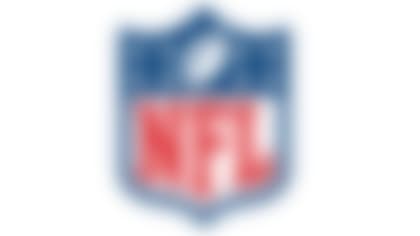In the NFL, April Fool's isn't limited to just one day or even one month. In fact, as we continue to work our way through the pro-day schedule, teams are starting to ramp up the trickery and skullduggery that annually mark the weeks leading up to the draft.
Trying to separate fact from fiction is tough at this time of the year. Teams are willing to get creative with the truth in order to advance their agendas. Most executives and coaches, for example, wouldn't hesitate to create the impression they're extremely interested in a prospect they have no plans of actually drafting, simply to create demand for the draft picks they hold -- and increase the haul that they would get in a trade. Possible smoke screens will start popping up all over the place as draft day nears, making it tough to tell whether a team is showing legitimate interest in someone or attempting to pull off a con.
Jeremiah: Mock Draft 4.0
Daniel Jeremiah provides his latest first-round projection. Two prospects on the rise: Dion Jordan and Tavon Austin. **More ...**
For example, the Jacksonville Jaguars sent a sizable group to watch quarterback prospect Geno Smith work out at his pro day last week, including owner Shad Khan, his son and head coach Gus Bradley. Are the Jags seriously interested in using the second overall pick to grab Smith? Or are they simply trying to convince the rest of the NFL that they are, in an attempt to increase the trade value of that pick? What about Philadelphia Eagles owner Jeffrey Lurie, who has also gone to watch Smith work out, and whose team holds the fourth overall pick? Or the reported decision by the Cleveland Browns, who are picking sixth, to schedule a private workout with the West Virginia product?
Let's say you're a general manager of a football team with a high draft pick. You've done your prep, so you know exactly who you want to select. You also know that a half dozen teams would pay through the nose for your slot -- not to draft your guy, whom you're sure would still be on the board six or seven spots below you, but to have a shot at one of those high-risk, high-reward quarterbacks everyone's buzzing about. You're not interested in drafting a quarterback, and you don't really need your pick to nab your guy, meaning you have a big advantage over the rest of the league -- and a golden opportunity to fleece one of those quarterback-desperate teams.
How, exactly, do you go about doing that? Moreover, how do you sift through the misinformation campaigns and media reports to form a coherent, solid plan for draft day? Here are a few proven strategies for playing the pre-draft game:
1) Create a favorable market.
If you hold, say, the third overall pick and you want to trade it away, you need to create demand. So you start calling around, maybe putting in a call to the GM of the team with, for example, the eighth overall pick. You say, "I know you're interested in a quarterback; what are you willing to offer me for my pick?" That team starts thinking about it. Before you know it, word gets out that they're interested in your pick. Other teams hear that and think, "Gee, if I want a shot at that pick; I'd better put together a good offer." Before you know it, you've got a choice of several trading partners competing to present the most appealing compensation for your pick. If you can pull off a trade by draft day, you'll get your man plus a handful of extra picks, either in the lower rounds that year or in the higher rounds next year.
The Minnesota Vikings did an excellent job creating a market for the third overall spot in last year's draft, pulling off a trade with the Cleveland Browns that landed them three extra picks simply in exchange for moving down one spot in the first round. The Browns used the third overall pick to draft Trent Richardson, while the Vikings were still able to get their man at No. 4, grabbing offensive tackle Matt Kalil.
Browns brass and Vikings GM Rick Spielman both denied that anything fishy had gone on, though reports did emerge that Spielman had been bluffing when he told Cleveland that several other suitors were also chasing that No. 3 slot. Either way, it worked out well for the Vikings, who were able to land the guy they likely wanted the whole time and get a few extra picks. Spielman also pulled off a nice trick this month, netting two extra picks in this year's draft (plus one for next year) when he shipped receiver Percy Harvin to the Seattle Seahawks. Personally, I think he's in the wrong business; Spielman should be an actor. He's done a fine job orchestrating these deals.
Jeff Fisher and the St. Louis Rams also deserve kudos for all the extra picks they got from the Washington Redskins in exchange for the second overall selection last year. Fisher wasn't going to pick a quarterback anyway, since he already had a signal-caller in Sam Bradford, but I'm sure he would have tried to convince people he was interested in Andrew Luck or Robert Griffin III. The deal worked out well for both teams, since Washington went to the playoffs with RG3, while the Rams improved from 2-14 in 2011 to 7-8-1 in 2012 -- and they'll get an extra first-round pick this year and next.
Finally, don't forget about former Arizona Cardinals personnel man Bob Ferguson, who traded the second overall pick to the San Diego Chargers in 1998. The Cardinals got San Diego's first- and second-round picks that year (which they used to draft Andre Wadsworth and Corey Chavous), plus a first-round pick the next year (used to pick David Boston) and two players (Eric Metcalf and Patrick Sapp). The Chargers got Ryan Leaf.
2) Use the media.
Brandt: Draft steals
You're probably quite familiar with the big-name prospects, but Gil Brandt identifies 12 sleepers in the 2013 NFL Draft. **More ...**
Another way to convince everyone that you are (or aren't) interested in a certain player is to leak things to your guys in the media. Reports help shape the constantly shifting pre-draft narrative, creating expectations that could prove to be to your advantage.
There used to be a guy named Fred Edelstein who would put out his own little independent news reports about the NFL. He had pretty good sources inside the league and he'd put out certain things.
Well, Edelstein was on ESPN during the 1992 NFL Draft, and he came out and said he knew without a doubt who the San Francisco 49ers were going to pick before it was their turn. When their turn came up, they picked Dana Hall -- not who Edelstein had predicted.
Edelstein's explanation? "Well, I guess they lied to me."
3) Keep it quiet.
Sometimes the best way to get what you want is to play no games at all. Don't spread any misinformation; don't tell any media guys what you're doing. Just keep it to yourself and swoop in on draft day to grab who you want.
Mike Shanahan did this with the Denver Broncos in 2006, when the Broncos traded with the Rams for the 11th overall pick so that they could draft quarterback Jay Cutler. This shocked everybody. Shanahan and the Broncos never publicly expressed interest in Cutler. Shanahan was operating almost as a single entity; he probably didn't tell anyone besides the owner about his plan. And as a result, he nabbed a high-end quarterback prospect.
4) Try to get it right.
This, of course, is the objective no matter what you're doing in the draft, but missing on a player can be worse if you've gone through a bunch of hoops and given up a bunch of picks to get him.
In 1982, when Dick Vermeil was coaching the Philadelphia Eagles and his friend Chuck Knox was coaching the Buffalo Bills, Vermeil let it be known that he was going to take Perry Tuttle, a receiver from Clemson, with the 20th overall pick.
Then, on draft day, what do the Bills do? They trade their 21st overall pick for the Denver Broncos' spot at 19. And who do they draft? You guessed it: Perry Tuttle.
Of course, Tuttle was out of the league two years later, while the player Vermeil drafted at No. 20 -- Mike Quick -- racked up 6,464 receiving yards and 61 touchdowns over nine seasons.
5) Listen to the chatter.
At the end of the day, draft success can be as simple as listening to what's out there.
In 1977, the Seattle Seahawks held the second overall pick in the draft. Tony Dorsett was a likely choice to be picked there, but his agent, Mike Trope, made it known that Dorsett absolutely did not want to play in Seattle. In fact, he indicated Dorsett would play in Canada (which was a viable option at the time) rather than suit up for the Seahawks.
I was working for the Cowboys at the time, and Trope told us that we should think about trying to trade with the Seahawks for their pick and drafting Dorsett. Well, that's precisely what we decided to do -- and landed a future Hall of Famer for our troubles.
Follow Gil Brandt on Twitter _@GilBrandt_.




